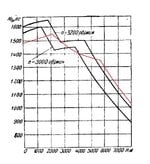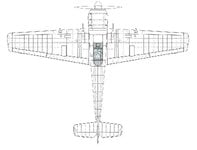Holtzauge
Airman 1st Class
Found this in Flight magazine years back. Can't imagine why nothing came of it? 

Follow along with the video below to see how to install our site as a web app on your home screen.
Note: This feature may not be available in some browsers.
Ad: This forum contains affiliate links to products on Amazon and eBay. More information in Terms and rules
I am sure that Bell was doing a lot of pen/pencil and paper on the early P-39s (although some of the pictures look like they turned things over to guys with hammers and an old tree stump.) With multiple revisions in just a few weeks.Oh, I'm quite sure that while they didn't have CFD back then, aerodynamicists did a lot of pen and paper work before any metal cutting was done. Just winging it isn't going to work anymore in the early 40'ies.
Well, both 109 and 190 were small fighters when compared with the US/UK types.That can get deceptive. The cooling drag on the P-47 was small in proportion to the total drag of the aircraft, Because the aircraft was so huge
What was the drag of the 190D-9 compared to late "G".
With the bigger wing and increased size of the fuselage.
Certainly not saying the there wasn't room for improvement on the G, there certainly was.
Agreed on all accounts.This requires a little more care.
You are introducing two 90 degree bends in the duct. You already have one. Now you may be able to turn the 90s into four 45s but you get the idea.
You also have to keep the ducts tight.
Putting the radiator outlets in front of the carb intake may not have been the best idea but you do what you have to do.
move along folks, nothing to see here.Found this in Flight magazine years back. Can't imagine why nothing came of it?
View attachment 804751
Same chart in Dean's says 6.27 sq ft for the Buffalo, 6.39 for the P-47B and 6.58 for the F4F-3 so there are huge variations in aircraft of near the same flat plate area.Fw data says that equivalent flat plate of the 190D-9 was 0.444 sqm, or 4.779 sq ft (that is for high speed). Same value is repeated at the Lednicer's paper.
Hoerner says that 109G (with lumps and bumps, ie. as draggy as possible 3-gun G) was 6.2 sq ft.
For comparison sake, Dean via NACA notes 4.63 sq ft for the P-39 (we already know that the P-39 was a very sleek fighter), and 5.71 for an (very early?) P-40; both US fighters being notably bigger than the Bf 109.
Just to add - Spitfre's (Mk.1's?) cooling drag was supposed to beFor sake of comparison, oil cooler D/q = 0.168, while the wing radiators' D/q = 0.660. Ventilation openings' D/q = 0.100. Hoerner says that the share of radiator(s?) on the total parasite drag was almost 16%*. He is also not fond on the surface imperfections and the skin friction.
I may be reading that wrong?Just to add - Spitfre's (Mk.1's?) cooling drag was supposed to be only 7% of the total drag.
link
Whoops, you are right. I'll edit the post.I may be reading that wrong?
I am reading it as 7lbs out of 59lbs of drag or 11.8% of drag.
On the other hand the Hurricane has 8lbs of drag out of 82lbs of drag for only 9.7% of total drag.

Re-reading the Hoerner's drag analysis of the Bf 109g
Biggest payoff, but also one of the most disruptive ones in the sense of changing the aircraft, would be getting rid of those draggy radiators. I kind of like my previously mentioned idea of a low-profile chin radiator, or a Mustang-style belly radiator, but given the Germans liked their annular ones (and those weren't bad either!), lets go with an annular one. However this would shift CoG forwards, probably necessitating moving the wings forwards as well or adding a FW190D style aft fuselage extension?
And while not maybe a big deal drag-wise, switch to a cut-back rear fuselage with a bubble canopy. With a low-angle rounded windscreen and smooth curves might even have less drag than the rather boxy canopy on the historical Bf 109?
Lets keep the DB 605. DB 603 or Jumo 213 are attractive, but given the delays with those we can't afford to wait for them to be ready. Instead have DB laser focus on improving the 605, obviously solving the valve and oiling issues, and then ASAP adopt a 2S supercharger for better high altitude performance.

And the landing gear will be of the bicycle type! If we want to fit cannons in the central wing section... I think the pilots will appreciate that creativity.The Bf 109X would've perhaps been a passable platform for the DB 603 or Jumo 213, especially if paired with the big wings from the 109T.
See here the 109X fuselage bashed together with the 109T wings; 4 cannons total:
View attachment 805173
MW-50 increased the maximum speed by about 50 km/h at all altitudes - the Bf 109G could be of equal performance to the Yak-9U:Looking a bit how the Bf 109 compares with better Soviet fighters - at least when these were in good shape, and/or as prototypes - the 109 still can came in short. Eg. the 109G-2 (ie. as clean as it gets) with a fully rated engine should still be a lot slower than the Yak-9U with the VK-107 engine, provided that the VK engine does not grenade itselfEven the MW 50 will not help it?
The prototype reached the speed of 700 km/h at 5600 m.The Yak-9U prototype was supposed to make 700 km/h.
The prototype reached the speed of 720 km/h at 5750 m.Same engine on the Yak-3 was supposed to bring 720 km/h, small size and drag of the fighter helping with the speed.
Either annular radiator, or something nicked from the Soviet or Italian fighters should've been the gain.
I'd go with the aft fuselage extension if the annular radiator is chosen.
MTT made a probably better canopy for the 109X (granted, that was an all-new aircraft anyway, so calling it yet another 109 is a major stretch), so dust off that for the in-series 109s? Although, Germans knew about the blown canopy of the Whirlwind before 1941, so there is another inspiration.
Unfortunately for the Bf 109 drivers, it was only the Soviets that concluded that the 'three gunned' 109G-2 was good for 660-670 km/h on Kampfleistung (2600 rpm, max 1.30 ata = max power at 5.7 km of 1250 PS). Germans tested the same thing as being good for up to 650 km/h. Before we get into the MW 50 benefits, the DB 605A needs to be improved in some important details so the engine can safely do the Notleistung (2800 rpm, max boost of 1.42 ata = max power at 5.7 km of 1350 PS). This is what will provide the additional speed - perhaps 15-20 km/h extra?MW-50 increased the maximum speed by about 50 km/h at all altitudes - the Bf 109G could be of equal performance to the Yak-9U:
So for an initial post-109F version (109Gaero?) which gets most of the benefits but has as few changes to the existing 109F as possible:
- Introduce the annular radiator.
- Since the fuselage has to be partially redone for the changed CoG, might as well introduce cut-down rear fuselage at the same time.
- Keep the historical wing, except for the radiators obviously. Perhaps add a couple of extra fuel tanks in place of the radiators?
- Retractable tail wheel, and wheel well doors.
- Armament is a bit of a question. Without the new wing, there isn't the place to put the two Mg 151/20'ies anywhere? Further, by adding the annular radiator, can the cowl MG's clear the cowling? If not, perhaps add back the MG FF's in the wing like on the 109E?
That's why I also cited the Finnish data - I doubted the Soviet data. Yes, to achieve Yak-9U characteristics it is necessary to refine the engine in addition to MW-50 injection. How was the Bf 109G handling at high speeds? How high were the loads on the control stick?.Unfortunately for the Bf 109 drivers, it was only the Soviets that concluded that the 'three gunned' 109G-2 was good for 660-670 km/h on Kampfleistung (2600 rpm, max 1.30 ata = max power at 5.7 km of 1250 PS). Germans tested the same thing as being good for up to 650 km/h.
Soviet pilots considered the difference in top speed of 10-15 km/h to be rather unimportant.Before we get into the MW 50 benefits, the DB 605A needs to be improved in some important details so the engine can safely do the Notleistung (2800 rpm, max boost of 1.42 ata = max power at 5.7 km of 1350 PS). This is what will provide the additional speed - perhaps 15-20 km/h extra?
I used this graph to estimate the increase of the maximum speed, but you are quite right - Notleistung was required to gain +50 kph. But even +30 kph were a significant improvement. The limit of 7 km was absolutely unimportant for the Eastern Front.The benefits of the MW 50 were limited to under 7 km in level flight for the DB 605A-engined 109s? See the graphs linked at the bottom of this web page.
I have often encountered the opinion of pilots that it was not the maximum speed that was important, but the speed that the airplane could realistically gain in combat. It was always lower than the maximum, but the difference from the maximum depended heavily on how fast the engine gained power, on the weight per hp, etc. In this sense, the Yak, for all its shortcomings, was noted as one of the best - it quickly gained speed in combat. In 1945, the VK-107A had a lifetime of 35 hours, but even ~670 km/h (actually more), which it provided for the Yak-9U, dramatically increased the efficiency of the fighter.Unfortunately for the Yak-9U drivers, indeed the engine was a dumpster fire, and the fighters in the units seems to just have been good for some 670 km/h.
That's why I also cited the Finnish data - I doubted the Soviet data. Yes, to achieve Yak-9U characteristics it is necessary to refine the engine in addition to MW-50 injection. How was the Bf 109G handling at high speeds? How high were the loads on the control stick?.
Depends on the standpoint? If your fighter is down by 30 km/h vs. the enemy's fighter, adding 15 km/h helps in making the speed difference indeed a trivial matter.Soviet pilots considered the difference in top speed of 10-15 km/h to be rather unimportant.
I used this graph to estimate the increase of the maximum speed, but you are quite right - Notleistung was required to gain +50 kph. But even +30 kph were a significant improvement. The limit of 7 km was absolutely unimportant for the Eastern Front.